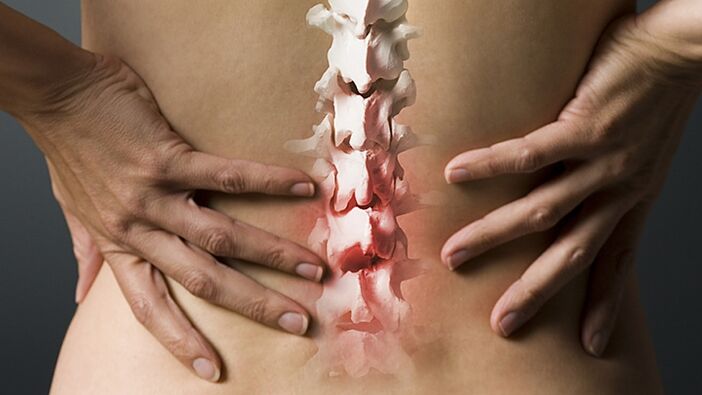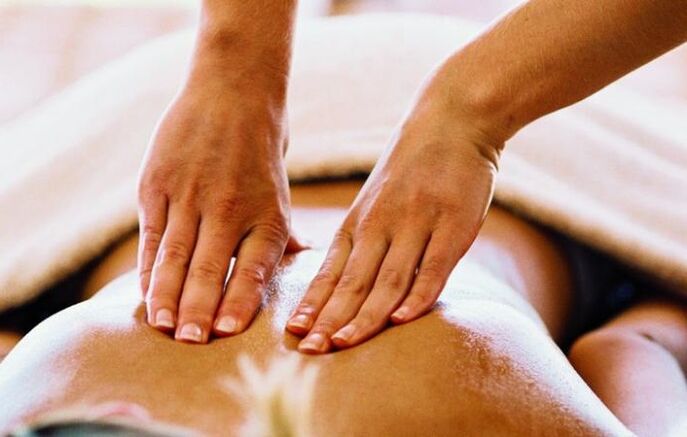
Spinal osteochondrosis is a disease characterized by degenerative-dystrophic changes in the vertebrae and intervertebral discs.
Scientists call this disease "civilization disease" because in the modern world it is associated with an upright posture and increasing stress on the spine. Usually, osteochondrosis begins to develop in young people between the ages of 20 and 25.
causes
The exact cause of the development of spinal osteochondrosis is not clear. Experts point out the factors that contribute to its development.
Traumatic factor. Constant overloading (microtraumas) of the spine contributes to accelerated wear of the intervertebral discs. Antiphysiological postures (working for a long time in a bent position, staying in one position for a long time) lead to the formation of subluxations in the intervertebral joints.
Pathology of the development of the musculoskeletal system. Flat feet, shortening of a leg, vertebral umbarization and other similar pathologies increase the load on the spine and thereby accelerate degenerative processes.
Age factor. The development of osteochondrosis of the spine is considered by many doctors to be a manifestation of the natural aging of the human body.
Vascular factor. A connection was established between a decrease in blood flow (ischemic processes) and an acceleration of pathological processes in the spine.
The factor of changes in hormone levels. Natural hormonal changes in the body (pregnancy, lactation, menopause, menopause) lead to an increase in degenerative processes.
The factor of endocrine-hormonal diseases. Diseases such as obesity, diabetes mellitus, myxedema (inflammatory lesion of the thyroid gland) and others contribute to the development of osteochondrosis of the spine.
Classification and Symptoms
Symptoms depend on the localization of the pathological process.
Osteochondrosis of the cervical spine. The cervical spine contains blood vessels that feed the brain. With degenerative changes in this section, the organs of the head are insufficiently supplied with blood. This often leads to cerebrovascular accidents.
The main symptom of cervical spine osteochondrosis is a headache. This pain is usually permanent, worse in the morning and with movement. It arises in the back of the head and gives off the parietal-temporal region. The pain syndrome is often accompanied by dizziness, flashing "flies", colored spots, in front of the eyes.
In addition, pinching the nerves often contributes to the occurrence of scalp, throat, and neck pain. Pain syndrome sometimes affects the arm, shoulder. It can be weakened or strengthened by turning your head or changing your posture.
Signs of osteochondrosis of the cervical spine are:
- Fluctuations in blood pressure;
- Ringing in the ears, hearing impairment;
- Visual impairment;
- violation of the coordination of movements and gait;
- Hoarseness or weakening of the voice;
- Caries;
- snore while sleeping.
Osteochondrosis of the thoracic spine. The manifestations can be various and depend on the localization of the disease and its severity. The compression of the thoracic nerve roots leads to intercostal neuralgia. It is manifested by acute chest pain that becomes more intense with inhalation, some movements, coughing and laughing. The pain syndrome increases after a person has been in one position for a long time or after physical exertion. Osteochondrosis of the thoracic spine is a common cause of diseases of the stomach, lungs, heart and other human organs.
Lumbar spine osteochondrosis. It often hits people who spend long periods of time in "sedentary work" (chauffeurs who work on computers).
A symptom of osteochondrosis of the lumbar spine is a painful aching character, which is aggravated with sudden movements (lifting weights, sneezing, coughing) and standing in one position for a long time. After a bent position, it is difficult for the patient to straighten the back, sometimes severe pain prevents smooth movement. The pain is significantly reduced in the horizontal position of the body. Squatting or lying on a healthy side brings relief.
The pain syndrome in osteochondrosis of the lumbar spine is often localized in the lower back and radiates to the legs, sacrum and often to the pelvic organs. Overloading the spinal muscles from awkward movements, lifting weights causes back pain. Lumbar osteochondrosis of the spine is often manifested in impaired sensitivity, numbness in the area of pain. The patient may feel a tingling sensation, "runny goose bumps". Symptoms are often accompanied by cramping of the arteries in the foot, a decrease in the temperature of the skin on the legs, and shivering in the legs. Some patients have dryness and peeling of the skin, sweating disorders.
If you think that you have osteochondrosis of the spine and symptoms characteristic of this disease, you should consult an orthopedic surgeon or therapist.
treatment

Therapy of this disease is aimed at eliminating pain, restoring the functions of the spine and preventing the development of dystrophic pathologies in the spine.
The duration of treatment for osteochondrosis of the spine depends on the severity of the disease, the patient's age and methods of treatment.
In the complex treatment of the disease, the following methods of therapy are used.
- Physical therapy. It is one of the most important methods of treating osteochondrosis. Physiotherapy exercises include joint gymnastics and exercises on rehabilitation equipment. Its result is the normalization of the nutrition of the intervertebral discs, the metabolism, the formation of the correct muscle corset and relief of the spine.
- Physical therapy. This method uses the effects of laser, ultrasound, magnetic field and low frequency currents on the body for treatment. The use of physiotherapy significantly shortens the duration of the treatment and increases its effectiveness.
- Massage. An effective way to relieve muscle pain, tension, improve blood circulation, general strengthening of the body.
- Manual therapy. This method of treating osteochondrosis of the spine makes it possible to restore the normal mobility of organs, improve blood supply and lymphatic circulation, and prevent the disease from worsening.
- Traction (traction) of the spine. With the help of special devices, the intervertebral spaces are enlarged. This will help restore the correct shape of the spine and eliminate pain.
- Reflexology. It consists in the action of special techniques on acupuncture points and reflexogenic zones of the human body.
Surgical treatment of osteochondrosis of the spine is carried out with the ineffectiveness of conservative therapy or with special indications. The scope of the surgery depends on the extent of the lesion and the symptoms of the disease.





































